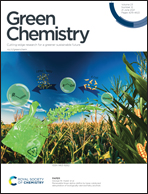More than a fertilizer: wastewater-derived struvite as a high value, sustainable fire retardant†
Abstract
Recovery of struvite at wastewater treatment plants provides a beneficial fertilizer while preventing costly operational issues due to precipitation in pipes, pumps, and digesters. At present, however, sale of struvite as fertilizer is hampered by low revenues. A higher value proposition of struvite is its use in phosphorus-based fire retardants, in which phosphoric acids released at elevated temperatures react catalytically with organic substrates to produce layers of carbon char that smother the flame. In this work, we evaluated the fire retardant performance of wastewater-derived struvite suspended in a low-cost viscoelastic hydrogel carrier (0.68% hydroxyethylcellulose, 0.12% methylcellulose, and 5% colloidal silica nanoparticles). The effectiveness of this formulation was compared to that of a conventional polyphosphate-based fire retardant in thermogravimetric analyses of wood samples and lab-scale burn tests of dry grass. The struvite-based formulation exhibited performance comparable to the polyphosphate retardant while requiring 60% less total phosphorus. Moreover, because struvite is derived from wastewater, applications of struvite in fire retardants can offset demand for mined phosphorus, a finite resource. Analysis of supply and demand for conventional fire retardants in the US indicates that wastewater treatment plants could produce sufficient amounts of struvite-based fire retardants to meet US demands for wildfire suppression while significantly improving revenues over direct struvite fertilizer sales. We conclude that wastewater-derived struvite is a promising green chemistry agent for fire retardants and can contribute to global phosphorus conservation.



 Please wait while we load your content...
Please wait while we load your content...